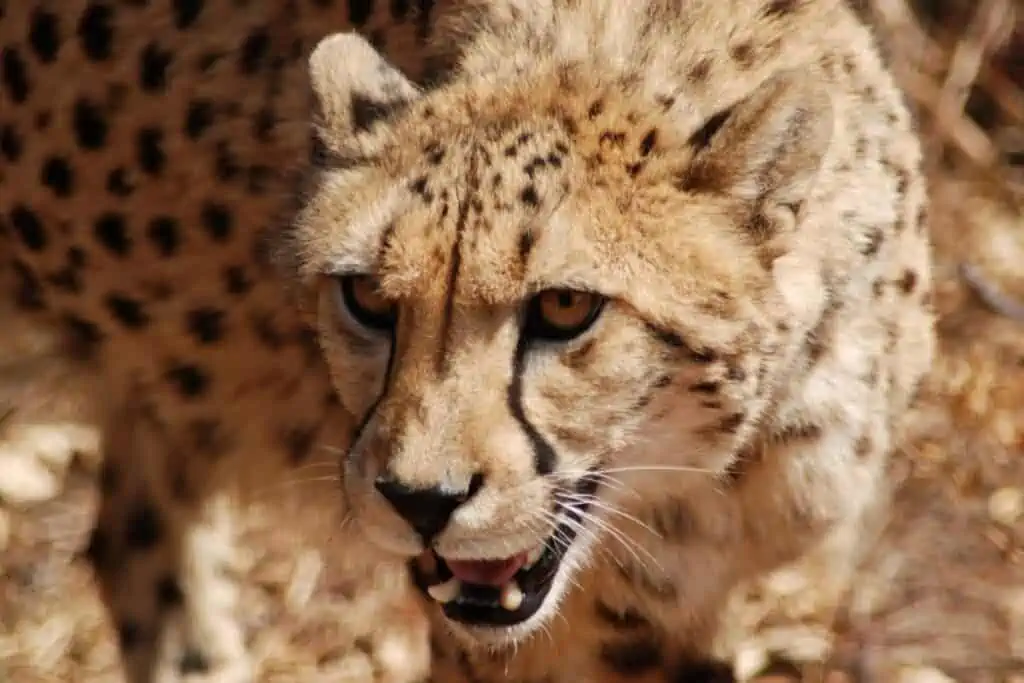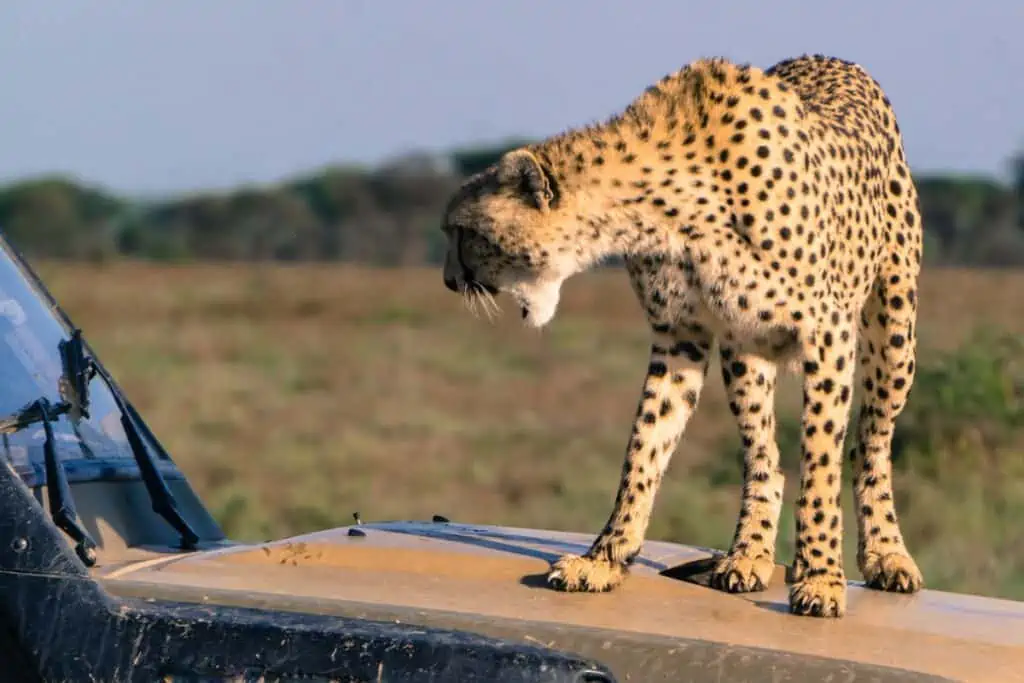The cheetah is one of the most interesting, beautiful, and let’s face it, downright cute animals in the world. However, if you’ve noticed the commonality between the spotted cat’s behavior and the way your pet housecat acts, you may be wondering: are cheetahs dangerous?
Although cheetahs are predatory animals and are, therefore, generally dangerous, no documented record of a wild cheetah killing any humans has ever been found. However, there have been instances of cheetahs that have been kept in captivity injuring human handlers.
In this article, we’ll look over whether or not cheetahs are friendly or are truly dangerous to humans, what causes their aggression, and how you ought to behave if they ever come into contact with a cheetah.

Are cheetahs dangerous to humans?
Whether you’ve been to the zoo recently or simply seen a documentary on these gorgeous animals, you’ll probably be struck by the same two, seemingly contradictory facts: cheetahs are amazing predators, and cheetahs look very huggable.
That second fact is probably due to how similar a cheetah looks to modern housecats. However, your pet kitty isn’t known for being Earth’s fastest land mammal or an apex predator.
So, are cheetahs dangerous to humans?
The truth is, yes, cheetahs can be dangerous to humans. This is due to the following three points:
- Cheetahs are predators.
- Male cheetahs protect their territory
- Cheetahs have hurt people before
Let’s break these down further so we can understand why cheetahs can be dangerous to humans.
Cheetahs are predators
Cheetahs are one of the dominant predators in their natural habitat. This is significant because most of the Earth’s cheetah population (which is unfortunately declining) shares a habitat with other predators like lions, jaguars, leopards, and hyenas. So to say that a cheetah is among these ranks of dominant predators is pretty intimidating.
Cheetahs are known for their speed. A cheetah can run at over 70 miles per hour. The average human being is only used to running at top speeds of 14 miles per hour, so even if their lives were at stake, a fleeing human wouldn’t be able to outrun a cheetah that wanted to attack.
Additionally, cheetahs have a bite force of 500 PSI, meaning they bite at least three times harder than we do. Crushing the bones of their prey and fighting off sturdy creatures like warthogs are a normal part of a cheetah’s life.

In 2021, a female cheetah named Izzy was on a routine walk around the zoo with her handlers when she suddenly decided to pounce on and attack a zookeeper they encountered.
The handlers suspected that this was because the zookeeper, although much different in shape and size from the cheetah’s typical prey, smelled like the giraffes and wildebeest he had been tending to. Predatorial instinct is attributed to the attack.
Male cheetahs protect their territory
In 2008, one of the only recorded cheetah attacks on humans occurred. Two cheetahs named Charlie and Matt attacked and injured their conservationist owner, who was known to enter their area and feed them regularly.
All big cats, even those in captivity, come to view their enclosures as their own territory.
While male cheetahs are the most aggressive in defending their turf during mating season, territory defense is still something that must be kept in mind when encountering any predatory animal. A cheetah is no exception.
Cheetahs have injured humans before
Although no known record of a wild cheetah attacking a human exists, it is not true to say that cheetahs have never injured a human being before.
In addition to the above two examples, cheetahs in captivity have unexpectedly proven that they can attack humans. This includes trained professionals.
Another example occurred in South Africa when an 18-year-old Belgian volunteer was watching a coworker feed the cheetahs inside their enclosure. A cheetah ignored the food and darted past while the gate was open choosing to charge and pounce on the volunteer instead.
Why a cheetah may be aggressive
We’ve covered the fact that some cheetahs may attack based on territorial protectiveness, even while enclosed, and we’ve also determined that cheetahs can confuse a human’s scent for that of their prey. But are these all of the reasons a cheetah may be aggressive?
In the wild, cheetahs are quite shy and are the most fragile of the big cats. They often avoid humans and have never been documented to hunt people.
There are many recorded instances of people provoking animals who would otherwise leave them alone by approaching them carelessly.
Cheetahs are not pets, and cheetahs in the wild will not be accustomed to having humans approach them for any good reason.
More often than not, they will run away from a human that gets too close, however, if a cheetah feels that its escape routes are cut off, or if it is trying to protect its young, it may act aggressively in order to defend itself.

How to behave around a cheetah
If you ever come into close contact with a cheetah, whether in the wild or in an enclosure, there are a few ways to behave so that both you and the cheetah have the best chance of leaving the situation unharmed.
- Don’t go alone – If you’re in an area where cheetahs may be present, such as on a safari, do not go alone. Groups easily deter cheetahs.
- Never get too close – If you spot a cheetah somewhere, don’t go up to it. The cheetah doesn’t know that you just want to take a selfie, make friends, or pet them. They will view an approach as a sign of aggression and may respond in kind. Don’t try to touch or get near a cheetah.
- Back away slowly – Normally, a cheetah will simply leave the area when coming across a human. However, if it can’t, or if it feels it needs to defend itself, it may act aggressively by turning and facing you. Your best bet is to back away slowly without running or turning your back on the animal until you are safe.
- Find safety – Trees are not safe from cheetahs. They can get up the trunk of a tree with their claws and speed much more quickly than you can reach a safe height. Instead, go to a place you know is secure, like a safari vehicle or a gate leaving the cheetah’s enclosure.
- Be frightening – Cheetahs are by no means the bravest of the big cat family. They can be intimidated by aggressively waving arms overhead, standing firmly, and making loud sounds like shouting or clapping.
- Fight it off – Don’t try and fight a cheetah unless it attacks despite your intimidation techniques. In that case, protect your throat and use your legs to kick the cheetah away. Cheetahs are lighter than most big cats and vulnerable. Don’t stop making loud noises; even if the cheetah withstands your screams, someone may hear it and come to help.
Final thoughts on how dangerous cheetahs are
Even though cheetahs are shy and will not attempt to eat a human, they are still wild and dangerous predators.
With such intense speed and a bite force much stronger than ours, any cheetah can pose a serious threat to a human if they are provoked and become aggressive.
Never approach a cheetah, especially if you are alone. If you do come into contact, though, and have no other choice, try to intimidate it while backing away slowly.

